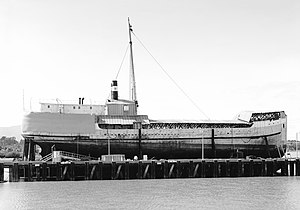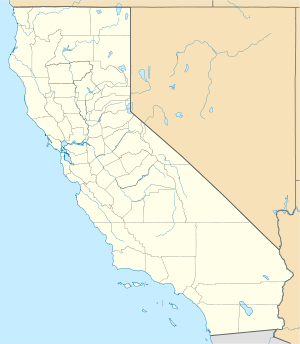Wapama (steam schooner)

Steam schooner Wapama in Richmond Shipyard, February 2006
|
|
| History | |
|---|---|
| Name: |
|
| Launched: | 1915 |
| Fate: | Dismantled in August 2013 |
| General characteristics | |
| Tonnage: | 945 (gross), 524 (net) |
| Length: | 216.91 ft (66.11 m) |
| Beam: | 42.33 ft (12.90 m) |
| Depth: | 19 ft (5.8 m) |
| Installed power: | 825 hp (615 kW) triple-expansion steam engine |
| Capacity: | 1,000,000 board feet (2,000 m3) of lumber |
|
Wapama (steam schooner)
|
|
 |
|
| Location | Richmond, California |
| Coordinates | 37°54′21.1″N 122°22′0″W / 37.905861°N 122.36667°WCoordinates: 37°54′21.1″N 122°22′0″W / 37.905861°N 122.36667°W |
| Built | 1915 |
| Architect | James H. Price; St. Helens Shipbuilding Co. |
| NRHP Reference # | 73000228 |
| Significant dates | |
| Added to NRHP | 24 April 1973 |
| Designated NHL | 20 April 1984 |
| Delisted NHL | 27 February 2015 |
Wapama, also known as Tongass, was a vessel last located in Richmond, California. She was the last surviving example of some 225 wooden steam schooners that served the lumber trade and other coastal services along the Pacific Coast of the United States. She was managed by the National Park Service at San Francisco Maritime National Historical Park until dismantled in August 2013.
Wapama was designated a National Historic Landmark in 1984; the designation was withdrawn in 2015.
Wapama was a two-masted, 216.91-foot-long (66.11 m) wooden schooner with a 42.33-foot (12.90 m) beam and a depth of 19-foot (5.8 m), net tonnage of 524, but a gross tonnage of 945. The Wapama was constructed in by St. Helens Shipbuilding Company, a subsidiary of the Charles McCormick Lumber Company, on Sauvie Island in Columbia County, Oregon in 1915. James Price was the master builder of the ship and oversaw a crew of 85-100 men at the company during the time of the Wapama's construction. The shipyard launched the incomplete Wapama, described as "little more than a finished hull", in a celebration on January 20, 1915. The ship was then towed to San Francisco by the Klamath for completion, but the ship drifted free during the tow and had to be caught by the tug Goliah of Merchants and Shipowners. The tow was completed by the first ship built by the St. Helens Shipbuilding Company, the Multnomah. Through February and March 1915, Main Street Iron Works installed the engine whilst the accommodations for passengers and crew were also completed. The Wapama officially entered into the service of the McCormick Lumber Company on April 29, 1915 and it cost a total of $150,000. The San Francisco Examiner reported, "The vessel will have accomodations [sic] for forty-five cabin passengers and fifteen steerage. The lumber carrying capacity will be 1,100,000 board feet."
Early on, the ownership of the Wapama was operated by the Charles R. McCormick Lumber Company, but changed for legal or corporate reasons. In 1915, it was sold to the Wapama Steamship Company for $10 and evidence indicates that additional investors owned a stake in the ship. In November 1922, the ship was transferred to the McCormick Steamship Company, after all other shareholders were bought out. In September 1925, it was transferred to the Charles R. McCormick Lumber Company. Throughout its service in the McCormick company, the Wapama transported passengers and cargo from San Francisco to the Northwest. In the Northwest, the ship would load lumber and passengers before returning to San Francisco. The ship would occasionally tow other vessels, like the lumber schooner Alpena and the whaler Bowhead, but were opportunistic and done at sea. The crew originally numbered 31, but was consolidated to 26 in 1927.
...
Wikipedia

